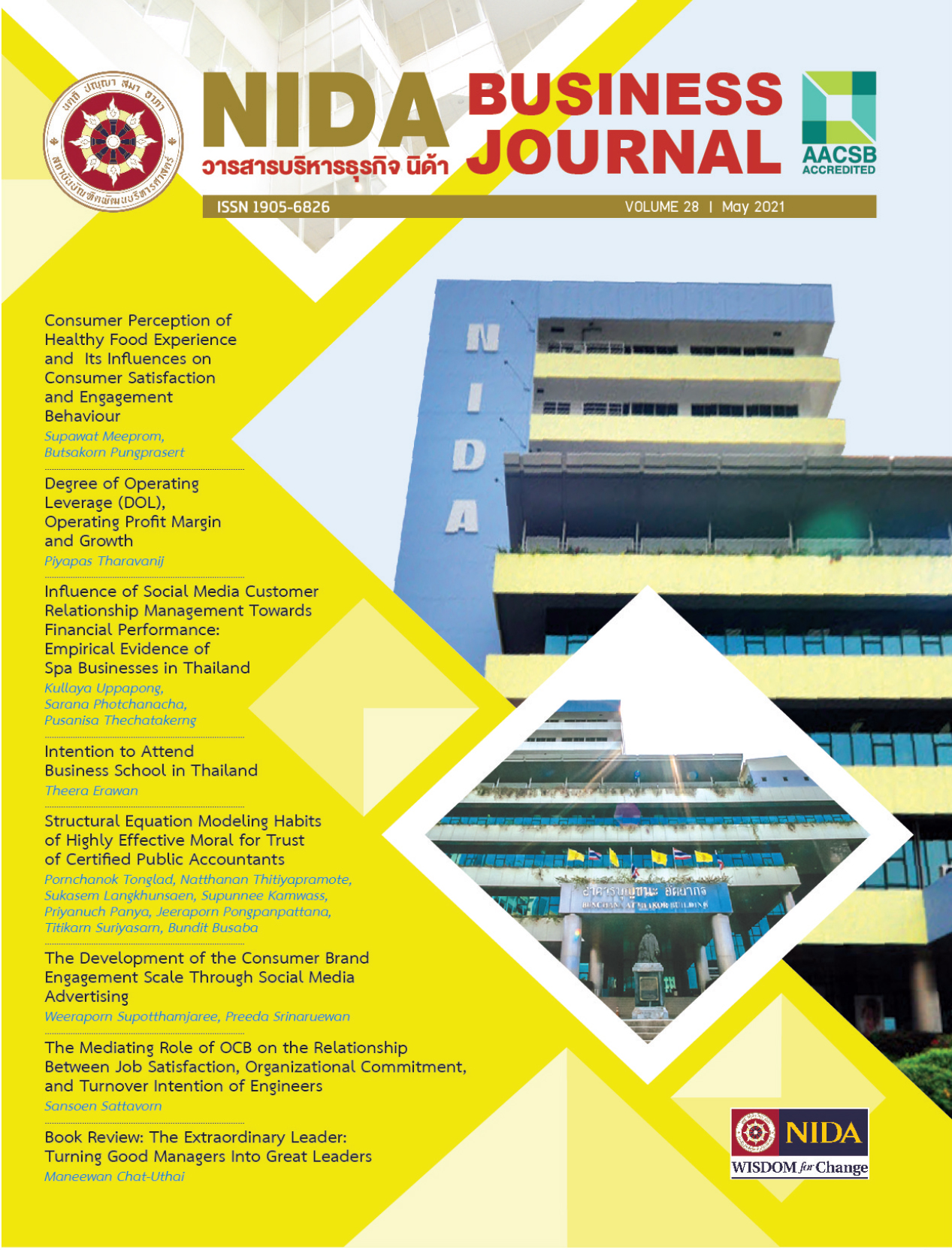ระดับความเสี่ยงในการดำเนินงาน (Degree of Operating Leverage: DOL), อัตราส่วนกำไรจากการดำเนินงาน (Operating Profit Margin) และอัตราการเติบโต (Growth)
คำสำคัญ:
DOL, Degree of Operating Leverage, อัตราส่วนกำไร, การเติบโต, ต้นทุนคงที่, ต้นทุนผันแปร, กำไรส่วนเกินบทคัดย่อ
บทความนี้ศึกษาถึง 1) ความสัมพันธ์ระหว่างอัตราการโตของยอดขาย ต้นทุน กำไร และอัตราส่วนกำไร (Margin) โดยเสนอสมการซึ่งเชื่อมระหว่างตัวแปรเหล่านี้ 2) วิธีในการประมาณค่า อัตราส่วนต้นทุนคงที่ อัตราส่วนต้นทุนผันแปร อัตราส่วนกำไรที่มีเหนือกว่าต้นทุนผันแปร (Contribution Margin) จากค่าอัตราส่วนกำไรจากการดำเนินงาน (Operating Profit Margin Ratio) และระดับความเสี่ยงในการดำเนินงาน (Degree of Operating Leverage: DOL) และหาค่ายอด ขายคุ้มทุน (Sales Breakeven) จากอัตราการเติบโตของยอดขายและกำไร ภายใต้สมมุติฐานที่ว่า ต้นทุนคงที่ไม่เปลี่ยนแปลง และอัตราส่วนต้นทุนผันแปรไม่เปลี่ยนแปลง 3) วิธีในการประมาณค่าตัวแปรข้างต้น โดยการผ่อนคลายสมมุติฐานให้ต้นทุน คงที่และอัตราส่วนต้นทุนผันแปรเปลี่ยนแปลงได้ โดยการเปลี่ยนแปลงดังกล่าวสามารถประมาณได้จากรายการในงบการ เงินและจากดัชนีราคาของแต่ละอุตสาหกรรม นอกจากนั้นงานวิจัยนี้ยังได้เพิ่มเติมวิธีการของ Arellano (2007) ซึ่งแสดง ความสัมพันธ์ระหว่างการเปลี่ยนแปลงของอัตราส่วนกำไรและต้นทุนคงที
ผลการศึกษาได้แสดงให้เห็นว่าถ้าอัตราการเติบโตของยอดขายมีค่ามากกว่าอัตราการเติบโตของต้นทุน กำไรของบริษัท ซึ่งมีอัตราส่วนกำไรสูงกว่าจะเติบโตในอัตราที่น้อยกว่ากำไรของบริษัทที่มีอัตราส่วนกำไรต่ำกว่า โดยผลจะเป็นตรงกันข้าม ถ้าอัตราการเติบโตของยอดขายมีค่าน้อยกว่าอัตราการเติบโตของต้นทุน
References
Arellano, F. (2007, 12 April 2007). Forecasting Profits in the Short-Run: Using a More Reliable Profit Margin Ratio. Retrieved from https://papers.ssrn.com/sol3/papers.cfm?abstract_id=980181
Guidry, F., Horrigan, J. O., & Craycraft, C. (1998). CVP Analysis: A New Look. Journal of Managerial Issues, 10(1), 74-85. doi: https://www.jstor.org/stable/40604183
Koh, A., Ang, S.-K., Brigham, E. F., & Ehrhardt, M. C. (2014). Financial Management: Theory and Practice, An Asia Edition. Singapore: Cengage Learning Asia.
Maher, M. W., Stickney, C. P., & Weil, R. L. (2011). Managerial Accounting: An Introduction to Concepts, Methods and Uses (11 ed.). USA: South-Western College Pub.
Mandelker, G. N., & Rhee, S. G. (1984). The Impact of the Degrees of Operating and Financial Leverage on Systematic Risk of Common Stock. Journal of Financial and Quantitative Analysis, 19(1), 45-57. doi:10.2307/2331000
O’Brien, T. J., & Vanderheiden, P. A. (1987). Empirical Measurement of Operating Leverage for Growing Firms. Financial Management, 16(2), 45-53. doi: https://www.jstor.org/stable/3666003
Prezas, A. P. (1987). Effects of Debt on the Degrees of Operating and Financial Leverage. Financial Management, 16(2), 39-44. doi: https://www.jstor.org/stable/3666002
Stelk, S., Park, S. H., & Dugan, M. T. (2015). An additional analysis on operating leverage estimation methods. Journal of Financial Economic Policy, 7(2), 180-188. doi: https://doi.org/10.1108/JFEP-10-2014-0056
Wahlen, J. M., Baginski, S. P., & Bradshaw, M. (2017). Financial Reporting, Financial Statement Analysis and Valuation (9 ed.). USA: Cengage Learning.
Zivney, T. L. (2000). Alternative Formulations of Degrees of Leverage. Journal of Financial Education, 26 (Spring), 77-81. doi: https://www.jstor.org/stable/41948329
Downloads
เผยแพร่แล้ว
How to Cite
ฉบับ
บท
License

This work is licensed under a Creative Commons Attribution-NonCommercial-NoDerivatives 4.0 International License.



